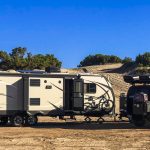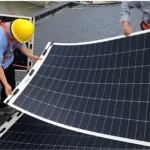what are solar panels on rv roof?
In the 19th century, scientists observed a photovoltaic phenomenon in which certain materials generate electrical charges and currents when exposed to sunlight. For many years, people have tried to harness the sun’s energy and build “solar engines”, but the results have been less than satisfactory, and most have been very inefficient.
It wasn’t until the 1950s that scientists discovered that silicon (found in sand) could be used to make highly efficient solar panels.
This discovery led to the development of solar cells, which harness the sun’s energy and convert it into electricity, which is how solar panels generate electricity. The technology has evolved over the years, slowly progressing from polycrystalline silicon to today’s monocrystalline silicon, but the concept has remained the same.
The range of applications of solar panels has also been extended, from home to outdoor, from outdoor to balcony, from balcony to wall, and developed to the current BIPV photovoltaic building integration. Knowledge articles about the range of applications of solar panels can be found in Sungold’s previous blogs.
This article is about the basics of solar panels on rv, what is rv solar system, how to mount solar panels on rv roof, let’s learn all about it together!
Solar panels on rv roof
RVs/vans/cars are always on the road and constantly exposed to solar radiation. To take advantage of this, many RV owners are becoming energy independent by installing RV solar panels on the roof or portable solar panels for RVs.
Because the roof constantly receives solar radiation, RV solar panels can generate large amounts of electricity to power DC and AC loads while on the road or camping.
With RV solar panels, you don’t need to stop at campgrounds to charge your batteries from an external electrical outlet or use an external diesel generator. The solar panels simply need to be exposed to the sun all day to generate power, as long as there are no objects blocking the RV solar module.
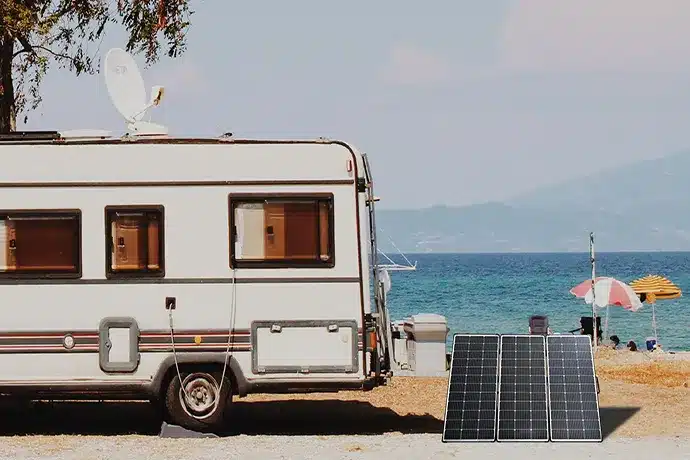
Pros and cons of solar panels on rv roofs
Understanding the pros and cons of solar panels on rv roofs is essential for you to choose the right solar panels.
Advantages
Independent Energy Supply: RV solar panels provide an independent source of energy for the RV, no longer relying solely on the campground’s electricity supply or needing to use a generator frequently. This independence allows for more freedom and flexibility in traveling.
Eco-friendly and clean: Using solar power is an environmentally friendly option that produces no carbon dioxide or other harmful emissions, helping to minimize the environmental impact and contributing to the environment at the same time.
Long-Term Reliability: Rigid solar panels installed on RV roofs typically have a lifespan of up to 20 to 25 years and can remain efficient with proper maintenance. This longevity makes it a reliable energy investment.
Reduced Costs: By utilizing solar electricity, you can reduce the need for campground electricity and save money on your electric bill. Fuel costs are also reduced because generators do not need to be used as often.
Disadvantages
Higher Initial Installation Costs: Solar panels are relatively expensive to install initially, including the cost of components such as panels, controllers, inverters, etc., which may require some investment.
Unstable capacity due to weather: The capacity of solar panels is affected by weather conditions, with energy production decreasing on cloudy days or nights when there is not enough sunlight.
Installation location limitations: Solar panels require a large installation space, and sometimes the reception of sunlight at the installation location needs to be taken into account, which may have an impact on the appearance of the caravan or the layout of the space.
Higher Installation Skill Requirements: Installing solar panels requires a certain level of technical knowledge and skill that may require a professional or higher level of installation skills.
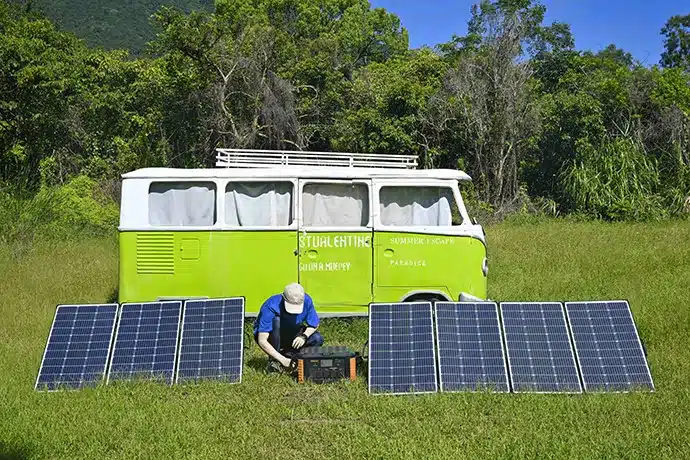
Types of solar panels for RVs
There are three main types of solar panels for RVs: monocrystalline, polycrystalline and amorphous.
Monocrystalline panels are the most efficient of the three, they will produce the most energy in the shortest amount of time and are the most popular on the market today.
Polycrystalline panels are slightly less efficient, but they are a durable and reliable option.
Amorphous panels are not as efficient as their counterparts, but their thin, bendable construction makes them easy to install and lighter in weight.
Sungold solar panels utilize high-efficiency monocrystalline silicon solar cells. The output efficiency of the solar panels is as high as 23%. Both portable and flexible solar panels are excellent solar solutions for your RV.
What is an RV solar system?
An RV solar system is a system that utilizes solar energy to power an RV.
This system enables RV owners to utilize solar energy to power their RVs, thereby reducing reliance on the traditional electrical grid while reducing fuel consumption and environmental impact. RV solar systems are a renewable, environmentally friendly energy solution that provides a sustainable source of energy for outdoor travel.
RV Solar System Components
Before we understand how to install a solar system, let’s recognize the RV solar system components. It usually consists of components such as solar panels, charge controllers, battery storage systems, and inverters.
RV Solar Panels
As mentioned earlier, your RV solar panels will be mounted on the roof of your RV, collecting energy from the sun via solar cells and transferring that energy (via a charge controller) to your battery bank. Your solar panels can be mounted flat, or you can choose to use a mounting method that allows you to tilt your solar panels towards the sun.
Batteries
The battery bank is the heart of your RV’s power system. The battery is where the energy provided by the sun is stored for use in the RV. Especially at night, when there is no solar energy, these batteries can provide energy. Your solar panels will charge the battery pack.
But not all battery packs are created equal, and not all battery packs are suited to the unpredictable charging cycles of solar systems. Lithium batteries for solar applications are a better choice than lead acid batteries.
Charge Controller
The charge controller is mounted inside the RV. Wires are connected from the solar panels to the charge controller and from the charge controller to the battery bank. The purpose of the charge controller is to control the rate at which the batteries are charged. The charge controller needs to prevent overcharging and operate the panel as efficiently as possible when using an MPPT charge controller.
Solar Inverter
The solar inverter converts the direct current (DC) electricity generated by the solar panels to the alternating current (AC) electricity needed in the RV. This conversion is done to meet the need for AC power for certain devices in the RV (e.g., TVs, laptops, kettles, etc.).
The batteries in the RV usually provide 12 volts DC, and the inverter converts this low voltage DC to the more common 120 volts (or other desired voltage level) AC to supply specific devices or appliances in the RV, such as coffee makers, fans, refrigerators, laptops, and so on. An inverter is one of the key components in an RV solar system that gives the RV more flexibility to use solar-generated electricity to support a wider variety of electronic devices.
Mount the inverter as close as possible to the battery bank in your RV and your AC appliances and equipment will receive converted (DC to AC) power from this inverter.
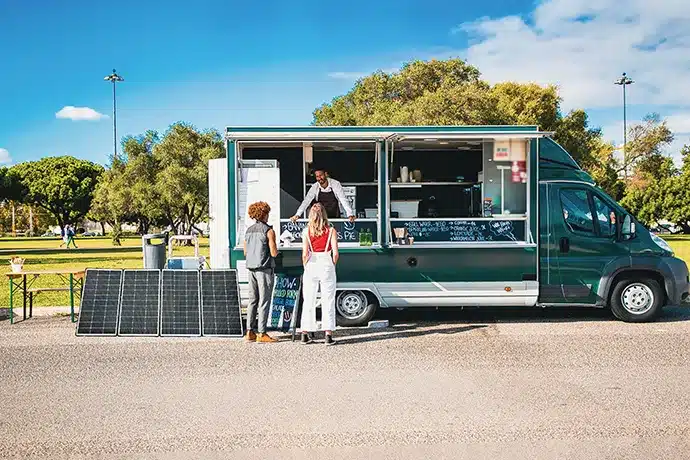
How to mount solar panels on rv roof?
While portable solar panels do not need to be mounted on the roof because they can be mounted on the ground at the campground, this is not the case with other types of solar panels (rigid solar panels, flexible solar panels). The sensible option is to mount them on the roof of the vehicle. There are different types of mounting systems:
Fixed Mount: fixed mount solar panels are the most straightforward method of mounting rigid or traditional solar panels. This type of installation requires you to drill holes in the roof of your RV and install solar racking to secure the solar panels in a flat position on top of the mounting system.
Flexible Installation: Flexible solar panels adapt to the shape of your RV, making them easier to install on any type of RV roof. To install these types of solar panels, the panels must typically be secured in place using VHB tape or 3M tape. You may also need to drill a hole in the roof to attach the cables into the RV, but this type of installation only requires one hole.
Tilt Mount: Instead of securing the solar panels in a flat position, you can use a tilt angle kit to mount the panels. This is a mounting system that includes a tilting platform that allows you to tilt your solar panels toward the sun depending on your camping location. This type of mounting system allows your RV solar panels to absorb more of the sun’s radiation and produce a higher power output, especially in the fall or winter.




